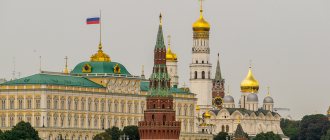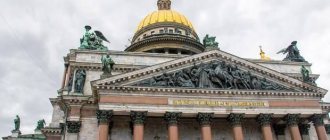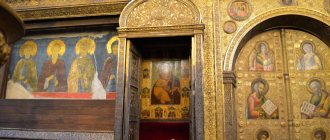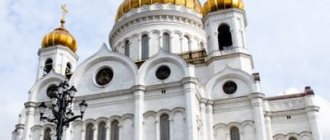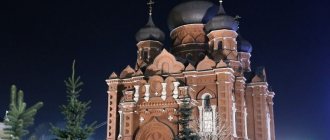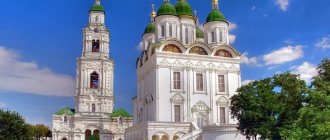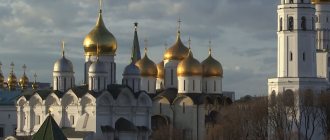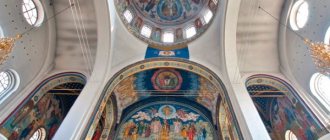History of the Annunciation Cathedral
During the existence of the Annunciation Cathedral of the Moscow Kremlin, it was rebuilt, reconstructed and completed many times. The first mention of the temple dates back to 1291. It is known from ancient legend that the order to begin construction was given by the son of Alexander Nevsky, Andrei. A wooden Annunciation Church was built on the territory of the Kremlin. There is a version that the cathedral was originally called the Church of the Nativity of Our Lady. In 1397, the icon “The Savior in a White Robe” was delivered to the church from Byzantium. According to some historical sources, it is believed that the church was built in the 14th century on the orders of the widow of Alexander Nevsky, who took monastic vows and dedicated the last years of her life to God.
In the 15th century, Ivan III, influenced by European architects, began a grandiose restructuring and reconstruction of the Kremlin. It was also decided to rebuild the Annunciation Church. In place of the wooden building, a three-domed temple grew on a white stone basement. The consecration took place on April 7, 1489. The ceremony was timed to coincide with the celebration of the great church holiday of the Annunciation and was conducted by Metropolitan Gerontius.
In 1547, there was a famous fire in the Kremlin, in which many buildings were damaged and people died. The Annunciation Cathedral also suffered significant damage. Restoration work continued until 1564. The temple was slightly expanded. On the western side, an extension was made to it, topped with two domes.
The Grozny porch was added to the cathedral in 1572. Its construction began on the orders of Ivan the Terrible. After his fourth divorce from his wife, he was excommunicated from the church. Standing on the new porch, he could listen to the liturgies taking place in the temple.
It is noteworthy that at the end of the 16th century, the most famous composer of that time, Fyodor Krestyanin, worked as a priest in the cathedral. Until the 18th century, the Annunciation Church was a personal parish of Russian sovereigns and their families. The rector of the cathedral was always the personal confessor of the king. Within the walls of the temple were kept the holy relics of the rulers: relics, ancient books and valuable vessels, especially revered images.
During the reign of the Romanov dynasty, the temple was protected and decorated. During the First World War, the cathedral's porch was significantly damaged by a destructive shell.
After the revolution, the Annunciation Cathedral was closed and it was turned into a museum. The main goal of cultural workers was to preserve the interior decoration and architecture of the building, its study and restoration. In 1989, the cathedral turned five hundred years old. In honor of this significant event, an exhibition of historical values and household items of ministers and famous parishioners of the church was organized.
The work of the temple was resumed in 1993. The first service took place on the patronal feast of the Cathedral of the Annunciation. The ceremony was conducted by Patriarch of All Rus' Alexy II. Since then, it has become traditional to invite the country's main clergyman to conduct a service on the patronal feast of the cathedral.
The basement of the temple today is one of the oldest architectural buildings in the Kremlin. Currently, it houses the “Treasures and Antiquities of the Moscow Kremlin” museum, open to visits by residents and guests of the city. The temple building is an example of Russian architecture and has great historical value. Unfortunately, the interior decoration of the temple walls has suffered significantly over the years: some of the ancient frescoes could not be preserved. A painting by the artist Theodosius, made in 1508, has been preserved. Modern painting accurately reproduces the lost drawings of past years. It is noteworthy that, along with icons, the walls of the cathedral are decorated with portraits of Russian tsars.
The Annunciation Cathedral is considered one of the most significant churches of the royal families. Thanks to numerous passages and galleries, it is part of the palace complex. Many foreign delegations passed through the cathedral galleries to get to the Moscow Kremlin. The Duma chambers of the boyars were located immediately behind the temple. The main role of the cathedral was that it was the home church of the royal families. Here the sovereign's offspring were married and baptized, funeral services were held for deceased family members, and the main persons of the state received communion and confession. The archpriest of the cathedral was necessarily the clergy of the tsar. His duties also included teaching and spiritually enlightening the sovereign’s children and drawing up a will.
Location
The architectural center of the Moscow Kremlin is Cathedral Square. Two magnificent historical monuments are located along its perimeter. The southwestern part of the square is occupied by the Annunciation Cathedral, which is often called the Golden-Domed Cathedral; it was consecrated in the name of the Annunciation of the Virgin Mary. The temple is a unique representative of ancient Russian architecture, the pearl of the Kremlin. Over the centuries-old history of its existence, it was rebuilt many times, decorated by each successive representative of the royal dynasty, but at the same time it did not lose its main purpose and original form. In order to determine who built the Annunciation Cathedral of the Moscow Kremlin, it is necessary to turn to the history of its creation. It is reliably known from chronicle sources that at the end of the XIV Cathedral it already existed.
Construction of the Annunciation Cathedral of the Moscow Kremlin
A new white stone building with three domes was built on the site of the wooden Annunciation Church. Construction took five years: from 1484 to 1489. The project for the building was developed by Italian architects. The construction work was carried out by Pskov craftsmen, famous for their skill. The result was a unique building in the style of Kremlin architecture with notes of Pskov architecture.
The foundation for the cathedral was laid on the site of the old building, repeating its shape. The walls were made of white stone. Initially, a rectangular building topped with three domes was erected. Small arches diverged from the main building, covered galleries were located around the domed part. The cathedral was connected with residential Kremlin buildings by a system of passages.
In 1508, by order of the sovereign, the domes were gilded. The iconostasis was decorated: the images of saints were covered with gold, silver and beads. In 1520 the porch was painted. The paintings were updated in 1648 and 1667. The paintings depict ancient Greek sages: Aristotle, Ptolemy, Homer, Plutarch, Anaxagoras, Menander. The ancient Roman prophetesses Sibyls are painted on the gate on the north side.
The iconostasis of the Annunciation Cathedral was originally decorated with icons painted by Andrei Rublev and Theophan the Greek. During a fire in 1547, they burned down and in their place were put two ancient rows of the same era: Festive and Deesis. The floor covering of the temple is unique: it is made of honey-colored jasper. Tradition says that Ivan the Terrible, while in Rostov, saw this material and ordered it to be delivered to Moscow for decoration of the cathedral.
After a fire in 1547, the main building was repaired and an extension with two domes was built on the western side. In the 60s of the 16th century, Ivan the Terrible ordered the expansion of the Annunciation Cathedral. Four chapels were added at the corners of the galleries, and two closed domes were erected in the western part of the building. The roof and domes were covered with gilded copper sheets. The Moscow Kremlin Cathedral became nine-domed, as can be seen in our time.
15th century
The temple owed its incarnation in stone to Vasily I (son of Dmitry Donskoy); it was he who ordered the foundation of a house church for the princely family. The main condition for the construction was its proximity to the living quarters of the chambers, so the townspeople called the cathedral in the Moscow Kremlin Annunciation the temple “in the entryway.” In 1405, the interior decoration was painted by famous Russian icon painters (F. Greek, A. Rublev). The architectural features of the created structure and its design reflected the influence of the Byzantine style, which was strong due to the emergence of Christianity in Rus' at that time. For more than 70 years the temple served unchanged and in 1483 it was destroyed by order of Ivan III.
Architecture
Exterior architecture of the temple
The Annunciation Cathedral is an example of a mixture of Moscow architecture and Pskov architecture. Erected on a basement preserved from an old wooden church. The appearance of the nine-domed temple with gilded domes has delighted the eyes of Russians since the 60s of the 16th century.
Under the domes of the cathedral, decorative semicircular niches were made around the circumference in the style of Pskov architecture. The facade of the building is decorated with “runner” and “curb” belts made of specially shaped bricks. In the style of Moscow architecture, tiers of kokoshniks and keel-shaped zakomaras were made, continuing with dissected shoulder blades. The main volume of the temple is complemented on four sides by attached chapels. The chapels are erected above the corners of the galleries and are small thin-walled churches topped with a golden dome. According to historical information, the chapels were built in honor of the wedding of the Russian Tsar Ivan the Terrible. Before the construction of the chapels, the Annunciation Cathedral was no different from many churches in Moscow, but now it has acquired voluminous beauty and grandeur, comparable only to the Intercession Cathedral.
The basement of the temple is much older than the building itself (about 200 years). It is located under the central part of the temple. It is made of white stone and has a quadrangular shape. A massive pillar is located in the center of the basement, from which low arches extend onto the walls. An apse is attached to it on the eastern side. Most likely, the royal treasury was kept in the basement.
The architecture of the Italian Renaissance is clearly expressed in the front galleries on the northern and eastern sides of the building: carved white stone capitals, panels on supporting pillars, ceilings with cross vaults. Through these galleries, the Tsar’s especially revered guests were solemnly escorted to the Pomegranate Chamber.
The southern and eastern galleries were erected in 1489. The eastern one has not survived to this day: it was dismantled along with the chambers attached to it. Most likely, the porch was added by mistake, since usually no extensions were made to the temple from the altar side. Initially, it served to connect the cathedral with the Treasury Chamber. The southern gallery is a closed room in which the chapel of Basil of Caesarea has been located since the 16th century. The kings walked along it to the palace from Cathedral Square.
Great changes have taken place in the external and internal decoration of the South Gallery. The western and eastern walls were rebuilt, the vaults were shifted, and the shoulder blades of the quadrangle were cut off. In the 19th century, the chapel of St. Nicholas the Wonderworker was built here. Later, a cathedral sacristy and an embroidery workshop were built in the southern porch. The decor of the building was significantly damaged and trimmed. Decorative elements were returned to the building after restoration work in 1949. The southern porch, located on the side of the Moscow River, is decorated with carvings. Initially it was open, then it was rebuilt and made closed. Along this porch, the Russian nobility went out into the palace garden, where they rested and distributed favors. The 15th-century carved portal made of white stone has survived to this day.
Initially, the southern porch was richly decorated with exquisite carvings. The surviving fragments testify to this. Beautiful patterns of acanthus leaves in bright colors decorated the capital and columns. In the 19th century, many elaborate decorative elements were replaced with crude copies.
Interior of the temple
The vaults in the Annunciation Cathedral of the Moscow Kremlin have a cruciform shape. The drum of the central tower is supported by four pillars. Since the cathedral was intended for the princely family, its interior was initially small. Later, the temple premises were expanded by adding additional chapels. Next to the eastern pillar there is an iconostasis. Wide choirs with a staircase leading to them are located in the western part. The legend says that during divine services the female part of the royal family was in the choir. But historians refute this fact, believing that the choir was separated by a two-meter brick wall and, judging by the characteristic drawings of the frescoes, there were three chapels: the Mother of God, the Cathedral of the Archangels and St. George.
The central part of the temple has high vaults, topped by a dome drum. During the day, the dome drum has good natural light from numerous windows, while the lower part of the temple remains dark. Initially, the windows on the southern and northern walls were very narrow, but they were widened in the 18th century. The central part of the temple was reconstructed many times. First, in the 17th century, the choir was dismantled, two centuries later they were restored, and the vault was blocked off with a flat ceiling.
The painting of the cathedral is quite traditional. The domes depict Christ the Pantocrator and the Mother of God. The walls of the temple are painted with images of famous scenes from the Gospel. In the western part of the wall are illustrated scenes of the Last Judgment. In addition to biblical images, the interior decoration of the temple contains the faces of the sovereign's ancestors. Handwritten images of Dmitry Donskoy and Ivan Kalita are on the pillars holding the vaults.
16th century
Who built the Annunciation Cathedral in the Moscow Kremlin that we see today? The question is not simple, the building was often updated in connection with fires in Moscow and as a result of wars and revolutions. The most significant changes in the appearance of the temple occurred during the 16th century. During his reign, Vasily III ordered the temple to be painted “richly”. The best icon painters in Rus' (Theodosius, Fyodor Edikeev) were involved in this work. The main motifs of the frescoes were preserved, but finishing and precious stones appeared in the decoration of the cathedral. The number of domes increases to 9 (the symbol of the Most Holy Theotokos in Old Russian Christianity), each of which is covered with gold, so the cathedral becomes Golden-Domed. According to his decree, the southern entrance is intended only for visits by the royal (princely) family, where they distributed alms and rested after the service.
Iconostasis
The majestic iconostasis of the Annunciation Cathedral is the main decoration of the interior of the temple. It consists of different parts brought to the cathedral at different times. Some parts for the iconostasis were made by modern craftsmen, and some have ancient roots and are considered a historical relic. Each component of the iconostasis was made for the Annunciation Church in honor of some significant event for Russia.
For example, the new Royal Doors of the iconostasis were made after Napoleon’s invasion of Moscow. The cathedral was looted by the French occupiers and the main valuables were taken outside the city. Among them were the Royal Doors. New gates were made in 1818. In the Annunciation Cathedral, they collected all the dilapidated silver items and smelted them into new gates. This can be learned from the inscription made by the craftsmen on the inside of the doors. The Royal Doors of the iconostasis, in the minds of Orthodox people, are a symbolic border between the Heavenly and Earthly worlds. Despite the differences in materials, they are very similar in all Kremlin cathedrals.
The image for the iconostasis of the Annunciation Cathedral was originally painted by Theophanes the Greek and Andrei Rublev. After the fire, icons belonging to the hand of the artist Theodosius were installed in their place.
The appearance of the Royal Doors in the Annunciation Cathedral of the Moscow Kremlin is quite traditional. The upper part of the doors depicts the Annunciation, the lower part is decorated with the figures of the four evangelists and their symbols. Unfortunately, the painted enamel, which was used to make the faces, hands and feet of the saints, has only partially survived; most of it was modified by modern masters during restoration. In 1838, the iconostasis was updated and new columns, a crown and a canopy appeared above the saints.
The setting for the iconostasis of the Annunciation Cathedral was made at the Moscow factory of the famous 19th century jeweler I.P. Khlebnikov in 1896. In 1894, the emperor announced a competition for the manufacture of the basement part, which was won by the architect N.V. Sultanov. He developed drawings for its manufacture. The base was made of hammered sheets of copper and decorated with ornaments in the style of the 16th-17th centuries. On the convex targets along the edges of the base part of the iconostasis there is an inscription stamped with the years of the beginning and end of the work.
The luxurious multi-layer frame of the iconostasis is made in three tones: white, blue and cherry. The material for it was a copper sheet. A gilded brass frame is placed on top of it and the whole thing is decorated with transparent mica plates.
Schedule of services in the Annunciation Cathedral in Moscow
Services in the Annunciation Cathedral are held several times a year, the largest and most festive being on the day of the Annunciation of the Blessed Virgin Mary on April 7 (March 25, old style). According to tradition, it is conducted by the Patriarch himself.
Services are also held in honor of the following holidays:
- Alexander Nevsky - December 6, September 12 (transfer of relics),
- Entry of the Lord into Jerusalem - April 12,
- Nicholas the Wonderworker - May 22 (transfer of relics), December 19,
- Cathedral of the Blessed Virgin Mary - January 8.
On ordinary days, the cathedral is accessible to visitors. Although services are not held, it is the most valuable Orthodox and historical monument of Russian history.
© Julia Alisova
How to get to the Annunciation Cathedral
The Annunciation Cathedral is located in the very heart of our capital - on Cathedral Square of the Moscow Kremlin. Not far from the temple there are three metro stations: “Alexandrovsky Garden”, “Library named after. Lenin" and "Borovitskaya". Borovitskaya station belongs to the Serpukhovo-Timiryazevskaya line. Travel time from the station is 9 minutes. "Library named after. Lenin" belongs to the Sokolnicheskaya Line. Travel time on foot is 14 minutes. It will take you the same amount of time to walk from the Aleksandrovsky Sad station, which belongs to the Filyovskaya line.
Address: Moscow, Manezhnaya street, 2-10. Tel.: +7 (495) 695-41-46.
Purpose
The Grand Dukes, and then all the Russian Tsars, used the Kremlin's Annunciation Cathedral as a local church. All family sacraments (baptism, wedding) were performed in it. The rector of the cathedral became the confessor of the ruler of Rus', he confessed him, helped to draw up and certified his will, and in long conversations could give advice to the tsar. The Annunciation Church housed the valuables of the princely (royal) family (relics, icons, relics of saints). The first Moscow princes kept their treasury in it. Each successive representative of the dynasty, having ascended the throne, tried to improve the decoration of the cathedral, add something of their own to its appearance, and leave a reminder of themselves to their descendants.
Photos
painting
The most ancient authentic examples of frescoes were lost during fires and reconstruction of the cathedral. Modern paintings are their copies; they were made by artists of the 16th century, who tried to convey the colors, shapes and meaning of the plots. Surprising is the fact that, along with traditional biblical motifs, the faces of Russian princes and ancient philosophers are depicted on the walls, vaults, columns, this gives uniqueness to such a monument as the Annunciation Cathedral of the Kremlin. Moscow, Russia does not have more ancient examples of temple painting. This museum houses works of religious art that have no analogues. The image of the Annunciation belongs to the most ancient and rare type of iconography.
